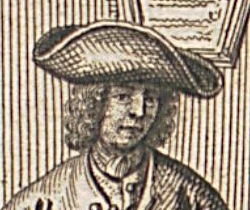|
|
You are not currently logged in. Are you accessing the unsecure (http) portal? Click here to switch to the secure portal. |
Johann Andreas Schmidt
| Johann Andreas Schmidt | |
|---|---|
 | |
| Born | ca. 1650 Marienberg, Erzgebirgskreis District, Germany |
| Died | ca. 1730 Tübingen, Germany |
| Occupation | Fencing master |
| Influences | |
| Genres | Fencing manual |
| Language | Early New High German |
| Notable work(s) | Leib-beschirmende und Feinden Trotz-bietende Fecht-Kunst (1713) |
Johann Andreas Schmidt was a German fencing master at the turn of the 18th century who ran his own fencing school in the Free State of Nuremberg, Bavaria, Germany, and practiced throughout Saxony Zöblitz. He was born in Marienberg in the Erzgebirgskreis District, Germany, in ca. 1650. Sometime after 1671 (or perhaps after 1675), Schmidt studied fencing under Johann Georg and Johannes Georgius Bruchius at the latter's school in Amsterdam. At the time, Amsterdam was an international and highly influential city and it appears that Schmidt had the good fortune of fencing with masters from Spain, Italy, France, the Netherlands and elsewhere while pursuing his fencing studies and training.[1]
Schmidt's fencing skill is illustrated by a story that is told of how in 1712, on a bet of 10 ducats and armed with just a stick, he took on "six strong farmers" in Altdorf in the area of Nuremberg. He defeated them all, thus winning the bet.[1] The following year, in 1713, he set up his fencing school in Nuremberg.[2]
Later he taught in Hildburghausen. In 1721, when he challenged to fight two other fencing masters, names unknown, before Bayreuth's Marquis, Georg Wilhelm von Brandenburg-Bayreuth (1678-1726). The challenge was fought in the vestibule of the royal hall in Bayreuth and Schmidt disarmed both repeatedly, thus gaining the favor of his new patron, the Marquis of Bayreuth, who elevated him to the position of Page Fechtmeister and granted him a salary of 1,000 guilders.[1] Afterward, probably after 1726 when his patron passed away, Schmidt returned to Nuremberg to continue his teachings. Then he moved on to teach in both Stuttgart and finally in Tübingen, where he died.[1]
In 1713, probably to promote his fencing school, Schmidt wrote a very extensive fencing and exercise manual entitled Leib-beschirmende und Feinden Trotz-bietende Fecht-Kunst ("The Body-Protecting and Enemy-Defying Art of Fencing"). The manual is dedicated to many, but first on the list is the man who is perhaps his patron, Hanns Carl Löffelholtz von Colberg. The 1713 edition was published in Nuremberg by Johann Christoph Weigel and Johann Michael Spörlin, and the book was republished in 1749, 1750, 1760 and finally 1780, all well after Schmidt's death.
Schmidt's lengthy fencing manuals (342 pages in the 1780 edition) are broadly divided into four parts. The first discusses the use and fencing arts with the single rapier after the German manner, which he had learned through Georg and Bruchius, which was itself heavily influenced by the teachings of the Italian master Salvator Fabris.[3] The second covers exercises by gymnastic techniques done on the pommel horse, and which in historic style is depicted in illustrations as a horse-shaped apparatus with the pommels (aka handles) being the front and back of the high saddle, itself done in 18th C. style. The third part of the manual provides more instruction on fencing techniques. Finally, the forth part provides lessons in wrestling, aka "the Ring", which portrays holds and take downs and appears to have its roots in the classic wrestling styles that accompanied teachings with the two-handed sword from the previous two centuries.[1]
Johann Andreas Schmidt died probably around 1730 in Tübingen, Germany.
Contents
Treatise
A copy of the second edition of his treatise is available at the Bayerische StaatsBibliothek and has been scanned and published online as Gründlich lehrende Fecht-Schule oder Leichte Anweisung, auf Stoß und Hieb sicher zu fechten : Nebst einem curieusen Unterricht vom Voltigieren und Ringen, Mit viel saubern darzu dienlichen Kupfern versehen, 1749.
A copy of the fifth edition of the treatise is available at the New York Public Library, where it was uncovered by modern day fencing student and instructor Thomas Van Hare. Being 374 pages long, it has been scanned and published in Google Docs and is available online at Johann Andreas Schmidts, Fecht- und Exercitienmeisters Fecht-Kunst, Nurnberg, 1780.
Additional Resources
The following is a list of publications containing scans, transcriptions, and translations relevant to this article, as well as published peer-reviewed research.
- Schmidt, Johann Andreas (2018). Johann Andreas Schmidt's Life-saving and enemies-defying Art of Fencing. Trans. by Reinier van Noort. Self-published.
References
- ↑ 1.0 1.1 1.2 1.3 1.4 Johann Andreas Schmidt. "[1]". A history of Johann Andreas Schmidt. Retrieved 16 January 2016.
- ↑ Johann Andreas Schmidt. "Johann Andreas Schmidt". Frontpiece from Fechtbook by Johann Andreas Schmidt. Retrieved 16 January 2016.
- ↑ Reinier van Noort. "Johannes Georgius Bruchius". School voor Historische Schermkunsten. Retrieved 22 February 2013.
